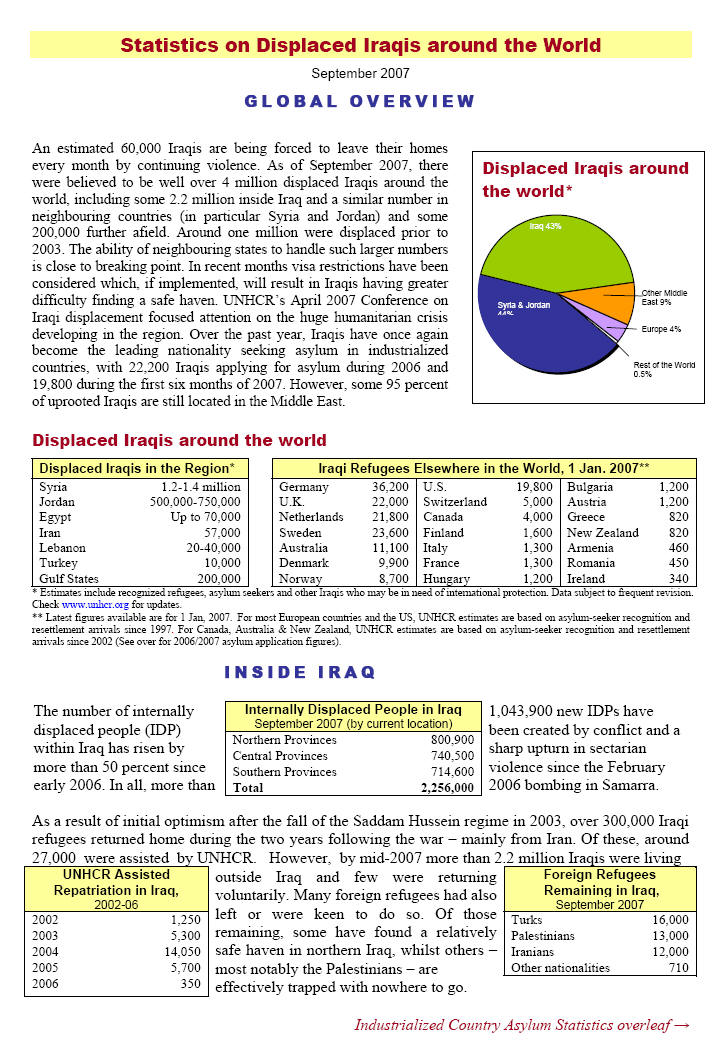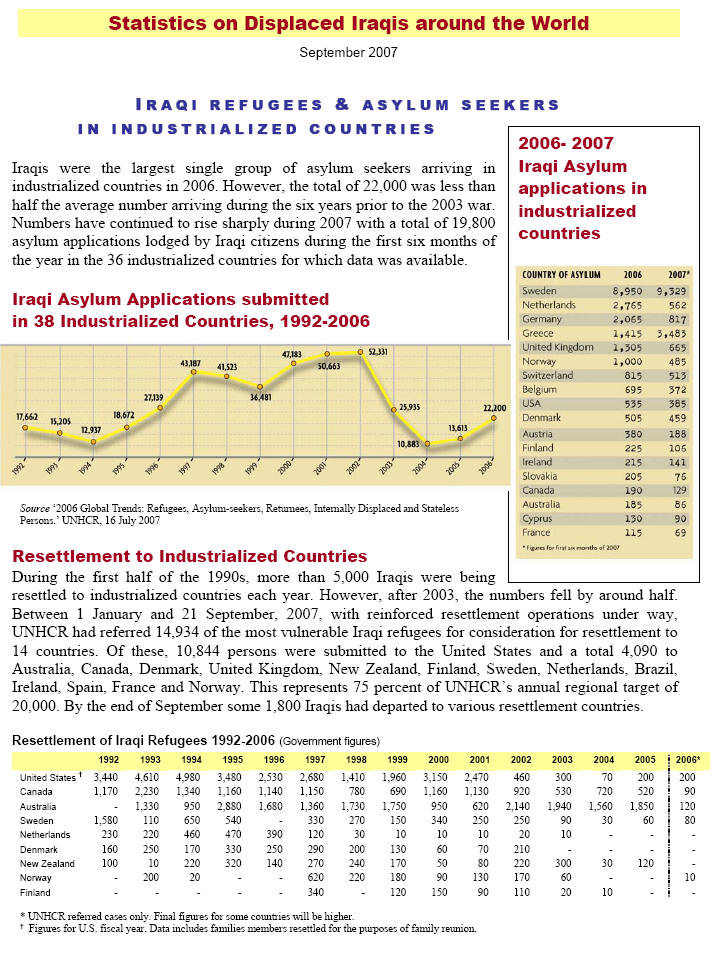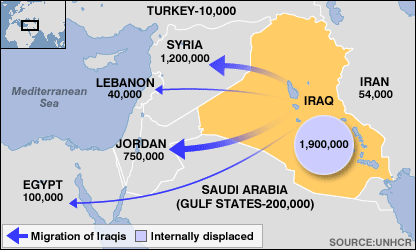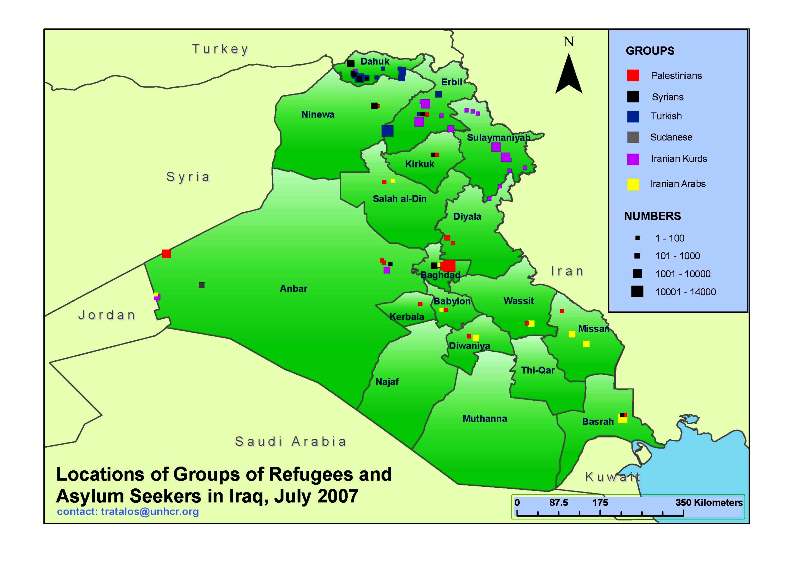R E F U G E E S


PDF report:
http://www.iraqslogger.com/downloads/unhcr_april2007.pdf

UPDATE 01
JULY 2007
The Iraqi Red Crescent Organization (Iraqi RC) provides relief
and humanitarian assistance to the Iraqi families who have been displaced
internally and externally. The Iraqi RC reaches the displaced people through its
offices in all governorates in Iraq as well as through its coordination offices
in the neighboring countries. This report provides statistics related to the
Iraqi families who are externally displaced. Statistics was obtained through
coordination with the Iraqi Embassy in Amman/Jordan, International
Non-governmental Organizations and particularly with the United Nations High
Commissioner for Refugees (UNHCR)
The Hashemite Kingdom of Jordan
1. Number of Externally Displaced Iraqis is
700,000-750,000 persons.
2. Number of registered Iraqi refugees is 30,000.
Iraqi RC Coordination Office in Amman:
Following Samarra' events (February 2006), many Iraqi families
left Iraq to neighboring countries. The Hashemite Kingdom of Jordan was one of
the countries which received displaced Iraqi families. The Iraqi RC Coordination
Office in Amman works with UNHCR to follow-up the flow of Iraqi families into
Jordan and to identify the main problems facing those families and to contribute
to alleviating their suffering. The following are priority areas that were
considered in surveys and assessments:
1. Health: Most families endure problems related to the
high fees of physicians and medical care, especially during the winter season,
and child health care and medical care for the chronically ill who used to
receive subsidized monthly medicines in Iraq.
2. Housing/accommodations: The high cost of rented
apartments is the main problem facing the Iraqi families. Most families do not
have the needed financial resources and are not receiving any support from any
humanitarian agencies for accommodations.
3. Renewal of visas/residence permits: Iraqis in Jordan
are considered as temporary visitors. Renewal of visas is difficult or limited
due to the strict procedures. Many quickly lose their legal status and become
subject to deportation. Most Iraqis in Jordan have not been officially
recognized as refugees by either the government of Jordan or the UNHCR.
4. Unemployment: Most Iraqis residing in Jordan have
limited employment opportunities. There is high unemployment rate even among the
highly educated. Without work authorization and with depleted savings, many
Iraqis (often over-qualified) seek and/or accept low-paying under the table work
or marginal employment.
5. Education: Iraqi children living in Jordan face
barriers to education. For Iraqis in Jordan, enrollment in schools or
universities is difficult due to the high tuition fees and/or the difficult
procedures of the public schools.
6. Newborns: Parents of Iraqi children born in Jordan
have the problem of obtaining the Iraqi nationality for their children. Most of
these families cannot afford the cost of ground or air travel to Iraq to
complete the related official procedures.
7. Food and nutrition: The high cost of food items in
Jordan had contributed to the hardships of the Iraqi families.
Iraqi RC assistance provided through Amman Coordination Office:
The Amman Coordination Office was inaugurated on 1 February, 2007. Since
then, the office coordinated with international organizations and the Iraqi
Embassy in Amman to provide humanitarian assistance to the Externally Displaced
Iraqis as follows:
1. Assisted in the field survey carried out by a joint team from
the International Federation of Red Cross and Red Crescent Societies
(International Federation) and the International Committee of the Red Cross (ICRC).
2. Provided financial assistance for the treatment of 100
persons with different medical problems.
3. Provided financial assistance for 100 families to assist in
the supply of food items.
4. Provided financial assistance for 50 families in cooperation
with the Iraqi Embassy in Jordan.
The Amman Coordination Office will continue its efforts to
deliver humanitarian assistance to the Externally
Displaced Iraqis as per regulations of the host country.
Syrian Arab Republic
1. Number of Externally Displaced Iraqis is
1,500,000-2,000,000 persons.
2. Number of registered Iraqi refugees is 15,000.
Iraqi RC Coordination Office in Syria:
The Syrian Arab Republic was another host country for the
Externally Displaced Iraqi families. The Iraqi RC Coordination Office in Syria
maintains a coordination role with the UNHCR regarding gathering statistics and
information related to the displaced Iraqi families, and identifying the main
problems facing those families and alleviating their suffering. The following
are priority areas that were considered in surveys and assessments:
1. Health: Most families endure problems related to the
high fees of physicians and medical care, especially during the winter season,
and child health care and medical care for the chronically ill who used to
receive subsidized monthly medicines in Iraq.
2. Housing/accommodations: The high cost of rented
apartments is the main problem facing the Iraqi families. The vast majority of
families does not have the needed financial resources and are not receiving any
assistance from any humanitarian agencies for accommodations.
3. Renewal of visas/residence permits: Iraqis in Syria
have difficulties in renewing their visas and/or obtaining residence permits due
to the large numbers of Iraqi arrivals. Iraqi families became subject to
deportation in case of inability to get a residence permit. On the other hand,
visa procedures for Syria are less restrictive than those for Jordan.
4. Unemployment: Most Iraqis residing in Syria have
limited employment opportunities. Similar to the situation in Jordan, there is
high unemployment rate even among the highly educated. Many Iraqis (often
over-qualified) seek and/or accept low-paying under the table work or marginal
employment.
5. Education: There are more Iraqi children living in
Syria than in Jordan. Official procedures related to enrollment in schools and
universities are easier than in any other host country.
6. Newborns: Parents of Iraqi children born in Syria have
the problem of obtaining the Iraqi nationality for their children. Most of these
families cannot afford the cost of ground or air travel to Iraq to complete the
related official procedures.
7. Food and nutrition: Most Iraqi families residing in
Syria need food and non-food relief assistance. Many Iraqi families obtain food
supplies from relatives in Iraq.
Iraqi RC assistance provided through Syria Coordination Office:
Since the opening of the Coordination Office in Syria and in cooperation and
coordination with UNHCR, the Iraqi RC was able to provide humanitarian
assistance to the Externally Displaced Iraqis as follows:
1. Assisted in the field survey carried out by a joint team from
the International Federation and the ICRC.
2. Provided financial assistance for the treatment of 20 persons
with different medical problems.
Arab Republic of Egypt
1. Number of Externally Displaced Iraqis is 150,000
persons.
2. Number of registered Iraqi refugees is 5,000.
Islamic Republic of Iran
Number of Externally Displaced Iraqis in Iran is
100,000 persons.
Lebanon
Number of Externally Displaced Iraqis in Lebanon is
40,000 persons.
Full report:
http://www.iraqslogger.com/downloads/ICRO_EDP_07_07.pdf
Mapping Displaced: Non-Iraqi Refugees in Iraq

Internally displaced persons in Iraq
– update 21 Nov 2007
The Cluster partners are UNHCR (Coordinator), IOM (Deputy Coordinator),
UNICEF, WHO, WFP, UNAMI, UNOPS, UN-Habitat, UNFPA, UNDP, ILO, UNIDO and OCHA.
One of the components of the International Red Cross and Red Crescent
Movement, the ICRC is a neutral, impartial and independent humanitarian
organisation that does not take part in the UN's cluster approach, rather it
is an observer.
Extract
1.2 Transferred/Displaced Persons Before 2006
- Cut off date 31 December 2005 (1)
The main reasons for displacement before the fall of the former regime
included human rights abuses, internal conflict along political, religious
and ethnic lines, the Iraq-Iran and Gulf Wars, drainage of the Marshlands,
construction of dams in the Centre, suppression of the 1991 uprising in the
South, competition over land and natural resources, and the “Arabisation”
policies of the former regime. With the fall of the former regime, the
US-led invasion and occupation of Iraq, the counter-insurgency operations,
and the secondary displacement of Arabs by returning Kurds, were amongst the
causes of internal displacement until the end of December 2005. In addition,
while many Iraqis returned both internally and from overseas, a considerable
number remained internally displaced, primarily due to a lack/destruction of
housing, inadequate employment opportunities and social services, the
presence of mines/UXO, and property disputes in their areas of return.
|
Governorate of
Displacement
|
Pre 2003
(families) |
2003-2005 8
(families)
|
Total families
displaced |
Total displaced
individuals |
|
Dahuk
|
22,452
|
22 |
22,474
|
134,844
|
|
Erbil
|
32,737
|
76 |
32,813
|
196,878
|
|
Sulaymaniyah
|
50,430
|
35 |
50,465
|
302,790
|
|
Total North9 |
105,619
|
133
|
105,752
|
634,512
|
|
Ninewa
|
1,947
|
4,625
|
6,572
|
39,432
|
|
Kirkuk
|
184
|
1,068
|
1,252
|
7,512
|
|
Anbar
|
218
|
4,685
|
4,903
|
29,418
|
|
Baghdad
|
2,281
|
1,586
|
3,867
|
23,202
|
|
Diyala
|
2,409
|
6,691
|
9,100
|
54,600
|
|
Salah al-Din
|
360
|
3,006
|
3,366
|
20,196
|
|
Total Centre10 |
7,399
|
21,661
|
29,060
|
174,360
|
|
Babylon
|
654
|
821
|
1,475
|
8,850
|
|
Basrah
|
15,494
|
284
|
15,778
|
94,668
|
|
Diwaniya
|
222
|
932
|
1,154
|
6,924
|
|
Kerbala
|
17,490
|
1,328
|
18,818
|
112,908
|
|
Missan
|
18,465
|
406
|
18,871
|
113,226
|
|
Muthanna
|
424
|
437
|
861
|
5,166
|
|
Najaf
|
3,833
|
160
|
3,993
|
23,958
|
|
Thi-Qar
|
657
|
3,569
|
4,226
|
25,356
|
|
Wassit
|
70 |
1,960
|
2,030
|
12,180
|
|
Total South11 |
57,309
|
9,897
|
67,206
|
403,236
|
|
Total families
|
170,327
|
31,691
|
202,018
|
|
|
Total
individuals |
1,021,962
|
190,146
|
|
1,212,108
|
Maps:
Iraq: Internally Displaced Families By Governorate - November 2007
IDPs (FAM) in Iraq - Governorate of Origin for Post Samarra IDPs
Iraq: Ability of IDPs to Transfer PDS Cards by Governorate - Nov. 2007
Iraq: Limitations to Physical Access and Restrictions to Registration of
IDPs by Governorate
1
IDP Families by Governorate
1.1 Internally Displaced Persons after February 2006
|
Governorate
of displacement |
Displaced
Families –
November 07
2 |
Displaced
Individuals -
November 07
|
|
Dahuk3 |
9,617 |
55,151 |
|
Erbil4 |
6,104 |
34,717 |
|
Sulaymaniyah5 |
13,165 |
73,534 |
|
Total North
|
28,886 |
163,402 |
|
Anbar6 |
10,225 |
61,350 |
|
Baghdad
|
59,346 |
365,618 |
|
Diyala
|
12,796 |
76,601 |
|
Kirkuk
|
6,604 |
36,315 |
|
Ninewa
|
12,118 |
66,970 |
|
Salah al-Din
|
5,326 |
31,017 |
|
Total Centre
|
106,415
|
637,871 |
|
Babylon
|
10,701 |
65,694 |
|
Basrah
|
4,158 |
26,110 |
|
Diwaniya
|
3,577 |
22,336 |
|
Kerbala
|
8,826 |
57,406 |
|
Missan
|
5,732 |
39,070 |
|
Muthanna
|
2,336 |
17,611 |
|
Najaf
|
10,400 |
60,459 |
|
Thi-Qar
|
6,140 |
40,107 |
|
Wassit
|
11,257 |
69,425 |
|
Total South
|
63,127 |
398,218 |
|
Grand Total
families |
198,428
|
|
|
Grand Total
individuals |
|
1,199,491 |
Notes:
(1)This figure is based on data gathered of IDPs in public buildings and
collective centres in the three Northern governorates (UNOPS/UNHCR), as well
as monitoring and needs assessments of IDPs in the 15 Central and Southern
Governorates (IOM). Cluster F is looking into supporting the Iraqi
authorities to update this figure and clarify the number of persons still in
displacement.
(2) This figure includes IDPs as well as Iraqi refugees from Iran who
returned into internal displacement.
(3) These include persons expelled during the 'De-villagisation' campaign,
the Anfal campaign, the 'Arabisation' campaign; persons expelled or who fled
due to Kurdish in-fighting, as well as those fleeing fighting between the
PKK and the Turkish military in Northern Iraq; Kurds expelled to Iran in the
1970s, and who have since returned to Northern Iraq but remain internally
displaced; Iraqis of all ethnic and religious backgrounds who fled
Government-controlled territory since opposing the Iraqi Government;
populations fleeing the Centre of Iraq after the fall of the former regime
due to religious/ethnic or political persecution and harassment (e.g.
religious minorities, intellectuals, Kurds from Fallujah and Ramadi), as
well as ongoing fighting between Coalition Forces/Multinational Forces (MNF-I)
and insurgents.
(4) These include Arabs, Kurds, Turkmen and Assyrians displaced to other
areas in the Centre during the 1980s as a result of the Iran / Iraq war;
Arabs displaced to the Centre since 1991 following the drainage of the
Marshes; Arabs displaced from their places of residence in the Centre as
part of the 'Arabisation' campaign from the 1960s through to the 1990s;
Kurds/Turkmen IDPs returning to the Governorates below the 'Green Line'
after the fall of the former government in April 2003; 'Secondary displaced'
Arabs fleeing in fear of harassment following the return of Kurds and
Turkmen from the North to their places of origin below the former 'Green
Line'; Populations displaced due to periodic fighting between Coalition
Forces/MNF-I and Iraqi Forces and insurgents (e.g. Fallujah, Ramadi, Samara,
Tal Afar, Al Qaim).
(5) These include persons displaced as a result of previous wars,
specifically the Iran/Iraq war during the 1980s; Shiites displaced due to
political/religious persecution (e.g. the 1991 uprising); Marsh Arabs
displaced since 1991 following the draining of the marshes; Smaller numbers
of Arabs displaced from their places of residence in the Centre (mainly in
April/May 2003); people displaced as a result of tribal and other conflicts
in the South; people displaced as a result of natural disasters,
specifically floods; populations displaced due to periodic fighting between
Coalition Forces/MNF-I and Iraqi Forces, and insurgents or armed militias (e.g.
Fallujah, Ramadi, Najaf).
Full_Report (pdf* format - 839,3 Kbytes):
http://www.reliefweb.int/rw/RWB.NSF/db900SID/AMMF-79BE2C/$File/Full_Report.pdf
MAPS
| 26 Nov
2007 |
UNHCR |
Iraq: Limitations to Physical Access
and Restrictions to Registration of IDPs by Governorate (pdf, 205k)
|
| 26 Nov
2007 |
UNHCR |
Iraq: Ability of IDPs to Transfer PDS
Cards by Governorate - Nov. 2007 (pdf, 170k) |
| 26 Nov
2007 |
UNHCR |
IDPs
(FAM) in Iraq - Governorate of Origin for Post Samarra IDPs (pdf,
201k) |
| 26 Nov
2007 |
UNHCR |
Iraq: Internally Displaced Families By
Governorate - November 2007 (pdf, 231k) |
| 29 Oct
2007 |
Le
Monde |
Les Réfugiés du Proche-Orient (Novembre
2007) (pdf, 801k) |
| 29 Oct
2007 |
WHO |
Map showing Cholera affected Districts
of Iraq (as of 16 Oct 2007) (pdf, 198k) |
| 16 Oct
2007 |
WHO |
Cholera in Iraq: Lab Confirmed Cases,
14 August - 5 October 2007 (pdf, 651k) |
| 01 Oct
2007 |
WHO |
Cholera in Iraq: Lab Confirmed Cases,
14 August - 25 September 2007 (pdf, 601k) |
| 01 Oct
2007 |
WHO |
Cholera in Iraq: Lab Confirmed Cases,
14 August - 24 September 2007 (pdf, 585k) |
| 01 Oct
2007 |
WHO |
Cholera/Acute Watery Diarrhoeal
Syndrome in Iraq: Cumulative Cases, 14 August - 19 September 2007
(pdf, 580k) |
| 19 Sep
2007 |
WHO |
Health Implications of the influx of
displaced persons from Iraq (pdf, 1,212k) |
| 07 Aug
2007 |
ReliefWeb |
Iraq: Location Map (jpg, 22k)
|
| 06 Aug
2007 |
UNHCR |
Iraq Situation Map (Situation as at
July 2007) (pdf, 923k) |
| 26 Jul
2007 |
UNHCR |
Iraq: Locations of Groups of Refugees
and Asylum Seekers in Iraq, July 2007 (pdf, 263k) |
| 26 Jul
2007 |
UNHCR |
Iraq: UNHCR National and International
Missions, Oct 06 - Jun 07, and Planned Missions, Jul - Aug, 07 (pdf,
469k) |
| 26 Jul
2007 |
UNHCR |
Iraq: Number of newly displaced (post
Samarra) IDP families (figures displayed on map) and numbers of
individual refugees (figures in separate table), by governorate,
July 2007 (pdf, 265k) |
| 26 Jul
2007 |
UNHCR |
Iraq: Number of newly displaced (post
Samarra) IDP families by governorate, 24 June 2007 (pdf, 212k)
|
| 26 Jul
2007 |
UNHCR |
Map of Iraq, showing ethnicity and
population (millions, by governorate). (pdf, 157k) |
| 26 Jul
2007 |
UNHCR |
Iraq: Access to Districts by UNHCR
partners, June 2007 (pdf, 304k) |
| 26 Jul
2007 |
UNHCR |
Major towns and cities in Iraq (pdf,
379k) |
| 13 Jul
2007 |
National Geographic |
Demographic Map of Iraq (pdf, 48k)
|
| 09 Jul
2007 |
UNHCR |
Iraq Atlas Map (As of April 2007) (pdf,
1,006k) |
| 15 Jun
2007 |
WFP |
Iraq - Overview (as of 4 Jun 2007)
(pdf, 2,215k) |
| 07 Jun
2007 |
Govt. USA |
Iraq: 2006 Baghdad Reference Map (pdf,
8,965k) |




